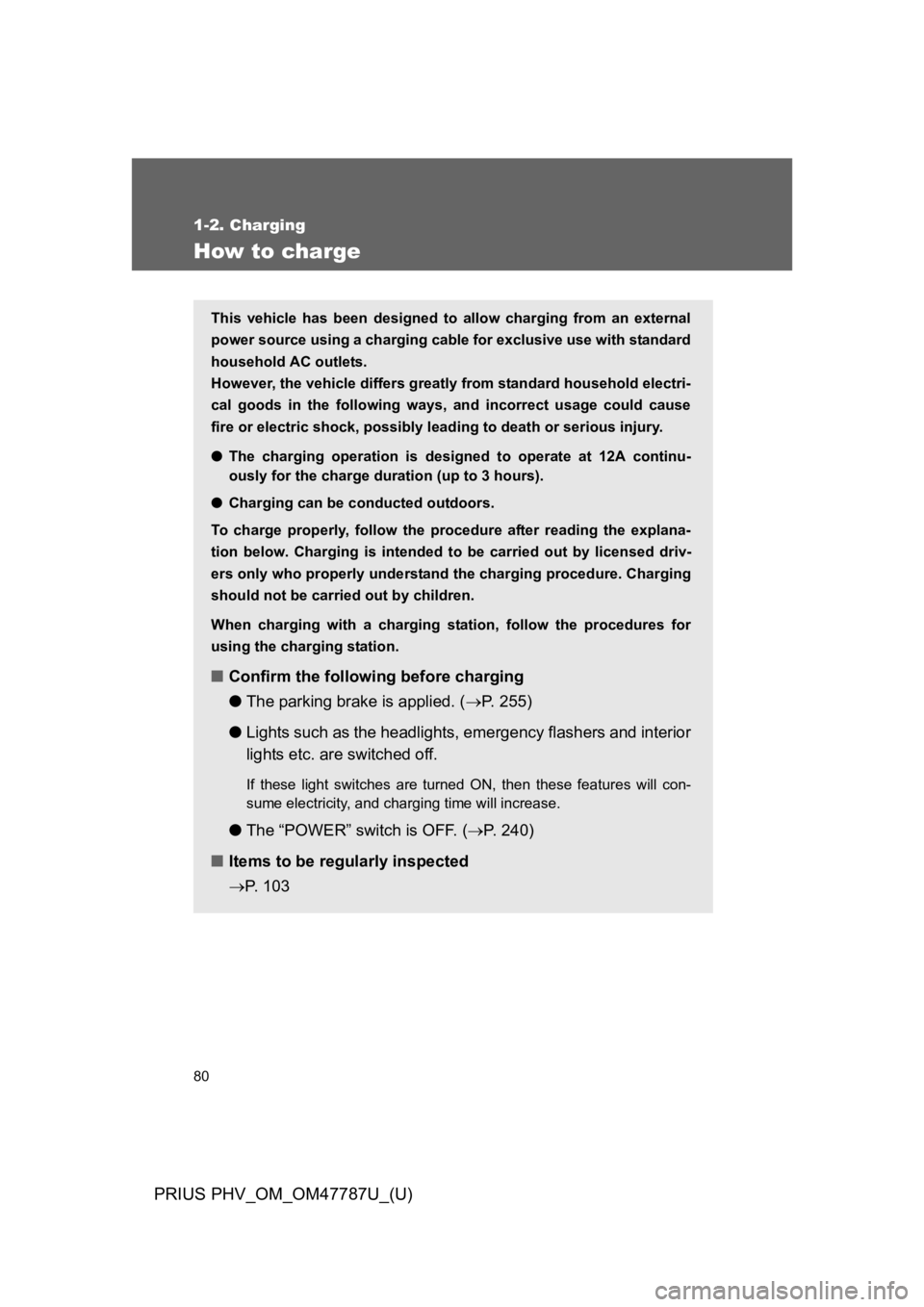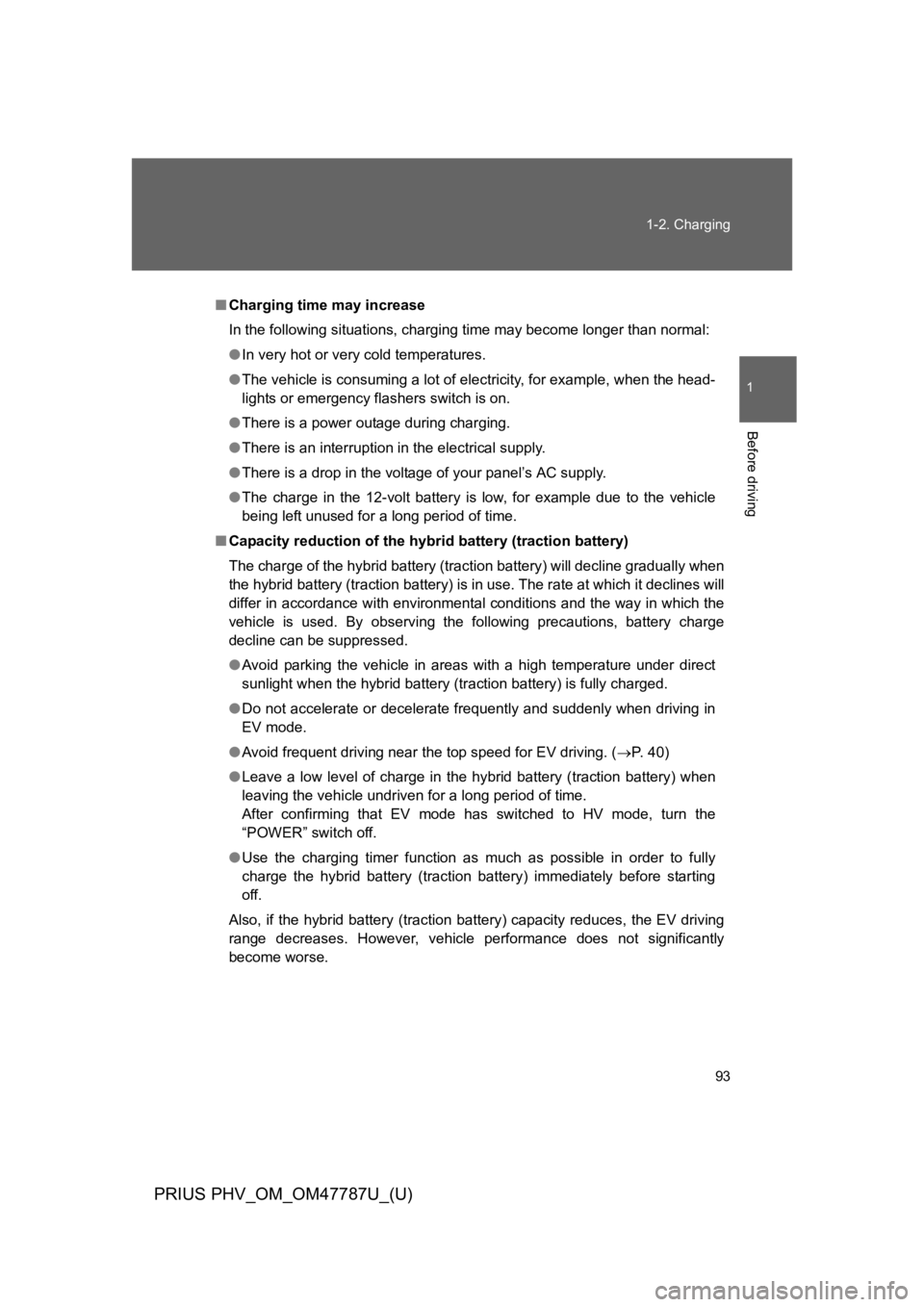Page 90 of 704
63
1-1. Plug-in hybrid system
1
Before driving
PRIUS PHV_OM_OM47787U_(U)
EV indicator*1
Eco Driving Indicator Light*1
Average speed*2
Average fuel consumption*2
Use the displayed average fuel
consumption as a reference.
*1: →P. 2 6 8
*2:The current amount since the trip
meter was reset will be displayed.
These functions can be reset by
pressing and holding the “TRIP”
button when either the 5-minute
or 1-minute interval fuel con-
sumption display is being shown.
Page 91 of 704
64
1-1. Plug-in hybrid system
PRIUS PHV_OM_OM47787U_(U)
Monthly fuel consumption record (multi-information display
only)
Press the “DISP” button to dis-
play the monthly fuel consump-
tion record.
Displays the average fuel consumption for the previous 6 months.
Average fuel consumption for
the previous 6 months
EV indicator*
Eco Driving Indicator Light*
Driving distance for each
month
*:→P. 2 6 8
Page 94 of 704

67
1
1-1. Plug-in hybrid system
Before driving
PRIUS PHV_OM_OM47787U_(U)
Plug-in hybrid vehicle driving tips
For economical and ecological driving, pay attention to the following
points:
■Using EV mode and HV mode effectively
Primarily using EV mode when driving in cities and using HV
mode when driving on highways (or freeways) can help con-
serve fuel and electricity. (→P. 3 7 )
■Using Eco drive mode
When using Eco drive mode, a torque corresponding to the
accelerator pedal depression amount can be generated more
smoothly than it is in normal conditions. In addition, the opera-
tion of the air conditioning system (heating/cooling) will be mini-
mized, improving fuel and electricity economy. (→P. 2 4 7 )
■Use of Hybrid System Indicator
Eco-friendly driving is possible by keeping the Hybrid System
Indicator within Eco area. (→P. 2 6 8 )
■When braking the vehicle
Make sure to operate the brakes gently and in good time. A
greater amount of electrical energy can be retained when slow-
ing down.
■Delays
Repeated acceleration and deceleration, as well as long waits at
traffic lights, will lead to high fuel and electricity consumption.
Check traffic reports before leaving and avoid delays as much
as possible. When encountering a delay, gently release the
brake pedal to allow the vehicle to move forward slightly while
avoiding overuse of the accelerator pedal. Doing so can help
control excessive electricity and fuel consumption.
Page 107 of 704

80
1-2. Charging
PRIUS PHV_OM_OM47787U_(U)
How to charge
This vehicle has been designed to allow charging from an external
power source using a charging cable for exclusive use with standard
household AC outlets.
However, the vehicle differs greatly from standard household electri-
cal goods in the following ways, and incorrect usage could cause
fire or electric shock, possibly leading to death or serious injury.
●The charging operation is designed to operate at 12A continu-
ously for the charge duration (up to 3 hours).
●Charging can be conducted outdoors.
To c h a r g e p r o p e r l y, f o l l o w t h e p rocedure after reading the explana-
tion below. Charging is intended to be carried out by licensed driv-
ers only who properly understand the charging procedure. Charging
should not be carried out by children.
When charging with a charging station, follow the procedures for
using the charging station.
■Confirm the following before charging
●The parking brake is applied. (→P. 2 5 5 )
●Lights such as the headlights, emergency flashers and interior
lights etc. are switched off.
If these light switches are turned ON, then these features will con-
sume electricity, and charging time will increase.
●The “POWER” switch is OFF. (→P. 2 4 0 )
■Items to be regularly inspected
→P. 1 0 3
Page 110 of 704
83
1-2. Charging
1
Before driving
PRIUS PHV_OM_OM47787U_(U)
Press the charging port lid to
open.
The charging inlet light will illu-
minate.
Remove the charging connec-
tor cap.
Affix the cap to the cable.
Insert the charging connector
into the charging inlet.
When inserting, make sure not
to press the latch release but-
ton.
Align with the guide position
shown on the underside of the
charging connector, and push
in until a click is heard.
STEP 4
STEP 5
STEP 6
Page 111 of 704
84
1-2. Charging
PRIUS PHV_OM_OM47787U_(U)
Confirm that the charging indi-
cator is illuminated. (When the
charging timer function is in
use, the light will turn off sev-
eral seconds after illuminat-
ing.)
Charging will not start if the
charging indicator does not illu-
minate when the charging con-
nector is inserted. (→P. 9 9 )
The amount of time until charg-
ing is completed can be
checked on the energy monitor
by turning the “POWER” switch
to ON mode. (→P. 8 9 )
The error warning indicator of
the CCID (Charging Circuit
Interrupting Device) has illumi-
nated during charging:
→P. 1 0 2
The charging indicator will turn
off when charging is com-
pleted.
STEP7
Page 119 of 704

92
1-2. Charging
PRIUS PHV_OM_OM47787U_(U)
■Charging timer function (finish time setting mode)
●The finish time setting mode should only be used as a reference for the
time at which charging will finish.
Charging may not complete at the finish time depending on the effects of
the electricity supply, temperature etc. In this event, charging will continue
until completed.
●If the function detects that charging cannot be finished on time, charging
will start immediately, and will continue until fully charged.
■Charging indicator
●The charging indicator illuminates if the Remote Air Conditioning System
(→P. 3 7 1 ) i s u s e d d u r i n g c h a r g i n g o r w h i l e t h e c h a r g i n g c a b l e i s c o n -
nected.
●If a system malfunction occurs during charging or during Remote Air
Conditioning System use, the indicator will flash for approximately 10
seconds and then turn off.
■When the outside temperature is low or high
The level shown on the remaining charge display (→P. 60) may drop slightly
when the “POWER” switch is turned to ON mode, even if charging has been
completed and the hybrid battery (traction battery) is fully charged. However,
this does not indicate a malfunction.
■Using a DC Charger
DC Chargers cannot be used with this vehicle.
Page 120 of 704

93
1-2. Charging
1
Before driving
PRIUS PHV_OM_OM47787U_(U)
■Charging time may increase
In the following situations, charging time may become longer than normal:
●In very hot or very cold temperatures.
●The vehicle is consuming a lot of electricity, for example, when the head-
lights or emergency flashers switch is on.
●There is a power outage during charging.
●There is an interruption in the electrical supply.
●There is a drop in the voltage of your panel’s AC supply.
●The charge in the 12-volt battery is low, for example due to the vehicle
being left unused for a long period of time.
■Capacity reduction of the hybrid battery (traction battery)
The charge of the hybrid battery (traction battery) will decline gradually when
the hybrid battery (traction battery) is in use. The rate at which it declines will
differ in accordance with environmental conditions and the way in which the
vehicle is used. By observing the following precautions, battery charge
decline can be suppressed.
●Avoid parking the vehicle in areas with a high temperature under direct
sunlight when the hybrid battery (traction battery) is fully charged.
●Do not accelerate or decelerate frequently and suddenly when driving in
EV mode.
●Avoid frequent driving near the top speed for EV driving. (→P. 4 0 )
●Leave a low level of charge in the hybrid battery (traction battery) when
leaving the vehicle undriven for a long period of time.
After confirming that EV mode has switched to HV mode, turn the
“POWER” switch off.
●Use the charging timer function as much as possible in order to fully
charge the hybrid battery (traction battery) immediately before starting
off.
Also, if the hybrid battery (traction battery) capacity reduces, the EV driving
range decreases. However, vehicle performance does not significantly
become worse.